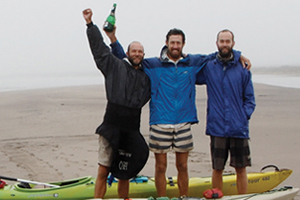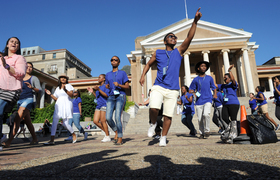First full eco-census of !Gariep
15 April 2013
Researchers wrap up the first full-length ecological census of the !Gariep - also known as the Orange River, South Africa's longest waterway.
It was under cover of fog at 05h30 on 16 March, that three kayaks slipped quietly under the border control bridge linking Alexander Bay to Oranjemund, towards the roar of the Atlantic; 61 days and 2 125 km after embarking from Qacha's Nek in Lesotho, just downstream from the source of the !Gariep River - or the Senqu, as it's known in these parts. The UCT trio had finally completed the last chapter of their Senqu2Sea expedition, the first mega-transect of South Africa's longest waterway, an artery that weaves through Lesotho, forms the border with Namibia, and provides vital water for irrigation and hydro-electric power. On a sandspit at the mouth, the trio of Ian Durbach, Sam Jack and James Puttick were met by Jack's girlfriend and his father - with a magnum of champagne to cap their achievement, the first full-length ecological census of the river's vegetation and ecosystems. "And all that we'd grown so accustomed to had now come to an end," Jack noted in their blog.
Abundant data
A couple of weeks later, PhD student Puttick, recent MSc graduate Jack, and Durbach, a statistical sciences lecturer, are back on campus, slowly reintegrating into a society with "too many people and too many cars", as Puttick puts it, sporting some "pretty weird calluses" - and even more data. These will take some months to process: 61 diatom and water samples, one collected every 40km along the river; 53 isotope samples from the tributaries of the Senqu and !Gariep rivers; over 1 200 GPS locations of interest, including 500 water abstraction points - places where water is extracted for irrigation, mining or human consumption. The expedition was supported by UCT's Plant Conservation Unit, the Mazda Wildlife Vehicle Fund, and the National Research Foundation's South African Environmental Observation Network (SAEON). The diatom samples are for a SAEON project led by Dr Jonathan Taylor at North West University. Roger Diamond, who leads an oxygen isotope project in UCT's Department of Geology, will study the water samples to get a picture of the different conditions in the tributaries' watersheds during rainfall events. The UCT trio also collected ornithological data from a host of sightings: Goliath Heron and Giant Kingfisher, and some 500 African Fish Eagle sightings. The water quality changed markedly along the length of the river, starting with opaque water, dense with silt, streaming in from scores of rivulets and tributaries in Lesotho - evidence of unchecked erosion. Numerous weirs along the South African stretch have their own effects on alien plant growth, as well as on fish populations and migrations. Closer to the Atlantic, diamond mining ramps up significantly, and mounds of stone, sand and debris were visible from the banks, prompting Jack's observation in their blog: "As ever, the search for balance between human and ecological needs goes on."
Photographic treasure chest
Puttick, who studies vegetation and climate change, has returned with a storehouse of photographs. They painstakingly document the river at two-kilometre intervals and from various elevations along its banks, capturing the surrounding landscape and its geology and flora. Each has a GPS position and will provide a good visual baseline for the effects of climate change. With little paddling experience before they set out (Jack had done some river guiding "years ago"), the journey was not without minor mishaps, the result of beguilingly-named rapids (Sjambok, Gamkab, Rollercoaster, Rocky Horror). But they met disaster only once, at a weir upstream of Orania, where Jack and Puttick's kayaks both sustained tail damage. As luck would have it, a local manufacturer of plastic water tanks sorted out the problem in his workshop and put the two back on the water. It was not the first or last time local hospitality helped them on their way. Paddling from the cooler highlands of Lesotho, temperatures soared to over 40°C at Augrabies, where their blog entry was headed: Hot Like Vindaloo. But the riverscape dictated the pace, and the simple life inventive (though Spartan) cuisine.
Naked nature
The trio were also privy to unusual sightings. Late one night they woke to thrashing sounds from the river. Torchlight revealed the heads of dozens of huge barbel, bunched together, mouths gaping open at the surface. "We'd seen this phenomenon at our camp below the Kum-Kum Falls, and had debated whether it might be some form of migration, perhaps to deeper water," said Durbach. "However, the aggressive splashing and herding formation in the direction of the shallows suggested some kind of pack-hunting strategy. Indeed, closer inspection revealed numerous smaller fish hiding in the shallowest water between rocks and pebbles." On another occasion they paddled up to a herd of gemsbok swimming across a channel in the river, only their heads and horns exposed. Unforgettable, too, was the guided tour of the Gariep Dam wall, by safety manager Joseph Alexander. After the trio had explained their mission to paddle the entire river, Alexander's entreaty was to become a mantra on long days of hard paddling into headwinds and other discomforts: "Guys, please - you must enjoy!" (Read more about their adventure at www.senqu2sea.wordpress.com.).
 This work is licensed under a Creative Commons Attribution-NoDerivatives 4.0 International License.
This work is licensed under a Creative Commons Attribution-NoDerivatives 4.0 International License.
Please view the republishing articles page for more information.










